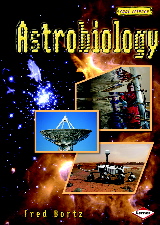The blogosphere and mainstream media have been buzzing for the past day or so about a new finding that changes our view of alien life. If you were looking for Little Green Men, you’ll be disappointed; but if you like  my 2008 book on Astrobiology, then you’ll realize the scientific importance of this discovery.
my 2008 book on Astrobiology, then you’ll realize the scientific importance of this discovery.
The new discovery is not surprising on the theoretical level. Astrobiologists are always considering alternate chemistry for potential life, so a life form that uses arsenic in place of phosphorus has always been in the realm of the theoretically possible. (Phosphorus is an important element in the “backbone” of DNA.) But the discovery of such organisms on the shores of Mono Lake in California turns hypothesis into fact.
Whenever I talk about astrobiology, one of my main themes is that life is an opportunistic phenomenon. It seems to arise in very challenging environments on Earth, so it is reasonable to assume that it arises elsewhere whenever conditions are suitable–including other worlds. This discovery broadens the kinds of life that astrobiologists can legitimately consider in observing the worlds of this and other solar systems.
In my book, I include a short section on life with other kinds of chemistry. I don’t explicitly mention arsenic replacing phosphorous, but I do follow the lead of Peter Ward’s outstanding book  Life As We Do Not Know It in discussing the possibility of life on Saturn’s hydrocarbon-rich moon Titan. That life might be based on silicon and could possibly use ammonia as the liquid that carries the vital chemicals.
Life As We Do Not Know It in discussing the possibility of life on Saturn’s hydrocarbon-rich moon Titan. That life might be based on silicon and could possibly use ammonia as the liquid that carries the vital chemicals.
Though carbon-based life with phosphorus in its DNA still seems most likely for Little Green Men, this new discovery opens up a whole new set of possible chemistries for simpler life forms.
For more details on the new discovery, follow this link to the online Astrobiology Magazine.
Please discover my other books for young readers.
Fred Bortz
So cool, Fred! These discoveries and discussions always challenge us to think beyond the familiar and the expected. And wasn’t that what they say was at the base of Einstein’s genius? His ability to imagine what might be possible.
You ALWAYS challenged us to THINK and to ask and to “realize” AND yes, YOU did mention the possibility of today’s announcement’
Thank YOU for BEING you and for challenging US to THINK!!!!!
Elaine Beck Oresti
Thanks, Domenica and Elaine.
For others reading these comments, Elaine was a member of a lifelong learning class I taught on Astrobiology at the University of Pittsburgh last summer. I used Life As We Do Not Know It as the main text.
She found this posting via an email to the class today. In that email, I wrote that I recalled including arsenic among the many possibilities for extremophile life chemistry. I wish I remember where I heard about that, because the person who mentioned the possibility surely was prescient!
Is arsenic (and arsenic-containing compounds) more common than phosphorus (and phosphorus-containing compounds) in any certain extraterrestrial environments? On Earth, phosphorus is estimated to comprise about 0.12% of the Earth’s crust (1000 ppm), whereas arsenic comes in at a feeble, trace percentage (1.5 ppm). That’s a really big difference. I guess a better way of asking this is to say: do we know any facts about the nucleosynthesis of either element, or their abundances on asteroids, moons, etc., to say whether the ratio of the abundance of each element on Earth is at least somewhat representative other, extraterrestrial environments?
On a different note, while I think this arsenic-successfully-replacing-phosphorus finding is interesting, all of it is moot until we know which factors lead to self-replicating molecules developing from raw materials in the first place. It’s also worth observing that the recent findings pertain to *cellular* organisms. Isn’t that a whole world of biochemical sophistication (and presumably long evolutionary history) beyond mere self-replicating molecules? I ask in earnest. If you can speak to this, Fred, I would be very grateful for any light you can shed!
Doug, I’m not an expert on this, but I’m certain the answer about arsenic-rich environments doesn’t lie in nucleosynthesis. But clearly there can be physical or chemical phenomena that lead to greater abundance in some regions or perhaps even some planets.
As to the development of self-replicating molecules, i.e. precursors to life and life itself, nature seems to be full of surprises. It apparently happens in all kinds of environments on Earth that we would call extreme (the organism would not, since that environment makes for a nice place to live and multiply), including unusual concentrations of elements or compounds that we consider toxic.
In my Astrobiology book, I describe life’s opportunistic nature this way:
Once life takes hold like that, there is nothing to stop it from spreading as long as the environment remains suitable.
Fred Bortz